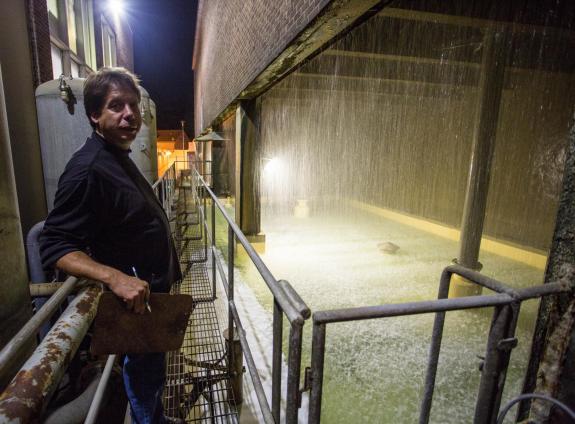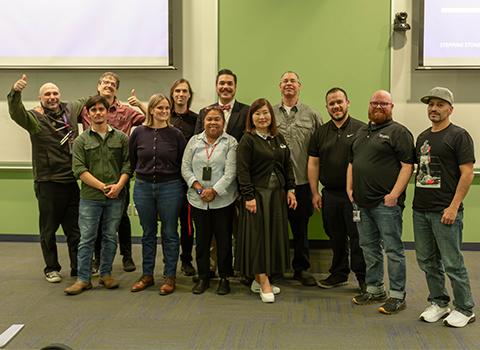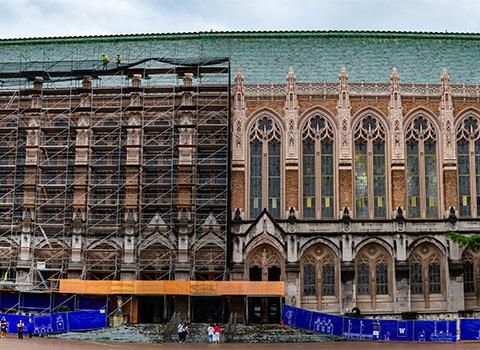Power Plant Night Owls

Keith Brett notes gauge readings on various pumps and equipment during his plant rounds.
The power plant shift operators include Brian Gallagher, Tom Bohn, Dan Stiles, Scott Gehrett, Mark Easton, Vladimir Kolesnik, Doug Conrad, Keith Brett, Josh Estes, Cuong Dinh, David Winston, Jimmy Ryals and Raymond Shell.
You may not ever think about what goes on behind-the-scenes when you walk into a nice warm building or hot water comes out of the faucet, but for a dedicated crew of around-the-clock engineers at the power plant, keeping campus comfortable is their highest priority.
“It’s a job nobody thinks about until something happens,” said Power Plant Operating Engineer 2 Keith Brett. “I feel like I’m responsible for making sure our hospital has power, a life-or-death situation, and for making sure our priceless research, like ice cores from the arctic, don’t melt because of heating or cooling issues. World-class research and lives depend on me to do my job.”
The campus power plant is responsible for producing steam, emergency electrical power, chilled water and compressed air for all campus buildings, including the Medical Center and Health Sciences building. A crew of 14 works in rotating shifts 24/7/365 to keep the Power Plant up and running day and night, including over holidays and during suspended operations.
The team has four shifts: a day shift, working from 7 a.m. to 3 p.m.; a swing shift, working from 3 to 11 p.m.; an overnight shift, working from 11 p.m. to 7 a.m.; and a relief shift that covers a day shift, two swing shifts and two overnight shifts, providing those crews with their weekends, so to speak.
Employees rotate shifts every four weeks, so all engineers cover night shifts at some point.
“The back shifts [night shifts] are interesting,” said Brett. “During the days there are dozens of people running around the plant—contractors, other Campus Engineering and Operations employees—it’s busy! Nights, on the contrary, are pretty quiet, aside from the loud machinery.”
The plant’s 14 engineers, often working as pairs, are responsible for monitoring equipment and making building rounds to read gauges, look for leaks and listen for any odd noises. The plant, at more than seven stories tall with multiple sub-basements and connections to campus’ steam tunnels, has a great deal of equipment to monitor.
“We get to play with fire, which is pretty cool,” said Power Plant Operating Engineer Lead Mark Easton, with a smile. “The flames in these boilers are honestly just so beautiful, I really enjoy the artistry of my job—everything falls into place. When all of the equipment is up and running, it really feels like they’re all humming along together, it sings! It’s music to my ears when I can tell that everything is up and running without problems.”
The plant is a noisy place, with engineers wearing earplugs and ear protection most everywhere they go. With five boilers, seven chillers, dozens of pumps and auxiliary mechanical equipment, there’s no shortage of things to monitor.

Vladimir Kolesnik inspects Power Plant equipment on his nightly rounds.
“This job is like working in a museum sometimes. There’s really old stuff buried in this building; there are boilers here from the forties, fifties and sixties that we still use, and remnants from campus’ original power plant that was run on coal shipped to us via the Burke-Gilman rail line,” said Easton. “Some of the older equipment, though in great shape, takes a bit more monitoring than the newer pieces.”
Boilers heat up water to steam, and provide that steam heat to buildings through seven miles of utility tunnels running beneath campus. Similarly, chillers remove heat from water and send it to campus buildings to cool the air in those buildings.
“As the weather cools at night we’ll make little changes to keep the campus buildings comfortable,” said Power Plant Operating Engineer 2 Vladimir Kolesnik.
As winter approaches, the engineers will add a third person to their shifts to help operate additional boilers to keep the campus warm.
“Boilers are a big part of the job here,” said Easton. “Elsewhere they have smaller boilers, but ours are huge high-pressure boilers. They take a lot of experience to operate.”
“It’s really neat working with this gigantic equipment,” said Brett. “It’s not something that everybody gets to do. We’re a close knit group and we really enjoy what we do.”
Autumn is a difficult time of year for the plant engineers as the weather can make it difficult to predict how much heat or chilled water to provide.
“In the autumn we provide both heat and air conditioning, but our machines don’t like running at their lowest capacity,” said Brett. “It’s a delicate balance we try to strike with the differential pressure in our chilled-water pipes.” While autumn may be the most difficult, power outages are when things get really intense.
“When systems go down, campus can rest assured that there are engineers at the plant working quickly to get things up and running,” said Easton. “It can take hours to build up steam pressure in our pipes for the hundreds of campus buildings we serve, but we’re always trying our best.”
“I was here during the small power outage in early September,” said Brett. “The key to success in this position is not panicking. We’re well-trained in what we do, and we’re prepared for any scenario that could come our way. A pump goes out? We just need to start up another pump. Power goes out and we need to restart the boilers? We can do that. It takes some time, but campus should know that we’re here and trying to get things back up and running as quickly as we can.”
“We all learn from each other as we move through the shifts,” said Kolesnik. “It doesn’t matter if it’s day or night, we’re here, and we just try to keep everything running and make things easier for the next shift. I don’t know that we’re any different from any other shift; we’re always just trying our best whenever we’re working.”
“We can’t wait to see what new energy technologies surface out of research here at the University, but for now we keep this place up and running so that our students and faculty can conduct that new and exciting research,” said Easton.




